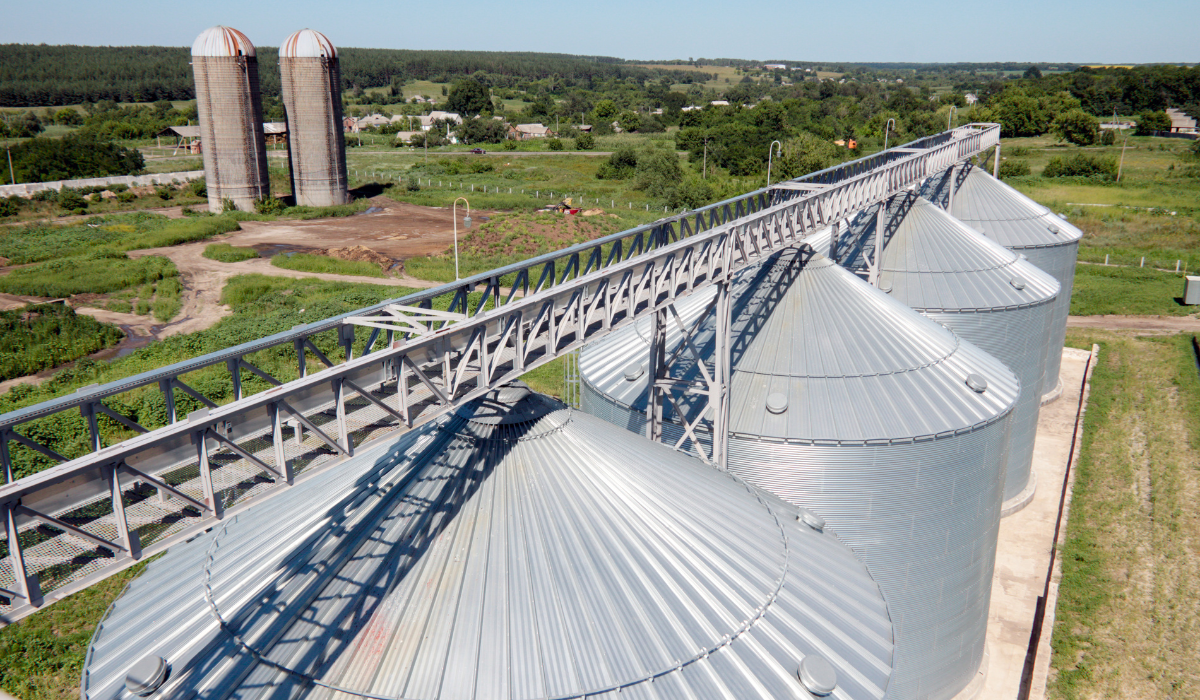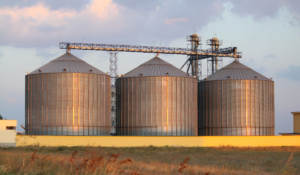With proper PPE and adherence to safety guidelines, the majority of incidents in the workplace can be avoided, including grain bin accidents. And yet, in recent years, data shows the frequency of these accidents on the rise.
In 2017, 23 grain bin entrapments and 12 deaths were recorded; 2018 witnessed 30 grain entrapments and 15 deaths; and in 2019, 38 grain entrapments led to 23 deaths.
Overall, grain bin entrapments rose by 65% over that 3-year period.
Farmers typically store products like corn and soybeans in elevated bins after the fall harvest. Once stored, these products then become used as feed, or sold in the following months.
In a typical year, these grains are air-dried during storage. When needed, an auger stirs the dry grains, so they flow steadily from the bottom of the bins onto a conveyor. It’s during this process that grain bin accidents become a serious issue. When an auger runs, or grain flows for any reason, entrapment and full engulfment can quickly occur.
In fact, according to OSHA, a person falling into in a bin has only two seconds to react, once grain starts flowing beneath him.
Sadly, a Nebraska feed mill worker has fallen victim to such an event, leading to a tragic outcome and more than $500K in OSHA fines.
Let’s find out what went wrong, and how this could have been avoided.

What Happened?
According to an OSHA investigation, on September 12 2022, a grain handler fatally suffocated after being engulfed in corn silo. Investigators said the 34-year-old male worker was attempting to clean out a grain silo at the Nebraska facility, without adequate safety gear. He later died on site after corn “engulfed and asphyxiated him,” the report said.
Notably, the feed mill allegedly ignored federal regulations, and the deceased did not have an adequate body harness and lifeline.
Investigators also said the company had a retractable lifeline tripod on site, which is not designed for side entry onto grain, and didn’t have another way to protect workers in silos.
Related Article: New OSHA Enforcement Guidance Set to Increase Penalties
Next Steps
Following the tragic event, the company was cited for 16 violations, including two willful and 14 serious, and faces $531,268 in penalties.
In addition, they have been placed the company in OSHA’s Severe Violator Enforcement Program. They have 15 business days from receipt of its citations and penalties to comply, request an informal conference with OSHA’s area director, or contest the findings before the independent Occupational Safety and Health Review Commission.
To prevent future occurrences, OSHA has partnered with the Grain Handling Safety Coalition, Grain Elevator and Processing Society and National Grain and Feed Association to address hazards, reduce risks and improve safety and health management systems.
From March 27 – 31, 2023; the National Grain and Feed Alliance will participate in its annual Stand Up 4 Grain Safety Week with a focus on making small changes for a big impact to improve safety in this high-hazard industry.
Related Article: OSHA Makes Major Update to Severe Violator Enforcement Program
Get Acquainted with OSHA’s Grain Bin Safety Standards
The grain handling and processing industry is a high hazard industry where workers can be exposed to several serious and fatal hazards.
These hazards include: fires and explosions from grain dust accumulation, suffocation from engulfment and entrapment in grain bins, falls from heights and crushing injuries, and amputations from grain handling equipment.
Here’s how you can reduce grain bin accidents at your location, and keep your workers safe;
- Turn off and lock out all powered equipment associated with the bin when not in use, including augers used to help move the grain. This prevents the grain from being emptied or moving unexpectedly.
Standing on moving grain is deadly; the grain can act like “quicksand” and bury a worker in seconds. Moving grain out of a bin while a worker is inside can create a suction that can pull the workers into the grain in seconds.
- Prohibit walking down grain and similar practices where an employee walks on grain to make it flow.
- Provide all employees a body harness with a lifeline, or a boatswains chair, and ensure that it is secured prior to the employee entering the bin.
- Provide an observer stationed outside the bin or silo being entered by an employee. Ensure the observer is equipped to provide assistance and that their only task is to continuously track the employee in the bin. Prohibit workers from entry into bins or silos underneath a bridging condition, or where a build-up of grain products on the sides could fall and bury them.
- Train all workers for the specific hazardous work operations they are to perform when entering and working inside of grain bins.
- Test the air within a bin or silo prior to entry for the presence of combustible and toxic gases, and to determine if there is sufficient oxygen.
- If detected by testing, vent hazardous atmospheres to ensure that combustible and toxic gas levels are reduced to non-hazardous levels, and that sufficient oxygen levels are maintained.
- Ensure a permit is issued for each instance a worker enters a bin or silo, certifying that the precautions listed above have been implemented.
For further information, read more on OSHA’s Grain handling facilities Standard 1910.272.
Bringing It Together
Grain bin accidents are serious, and as you can see, even deadly. Make sure you and your team follow the proper procedures, and instill a ‘safety first’ attitude.
The confined spaces of a grain bin or silo requires extra precaution to keep workers safe and business operations running smoothly. In the end, cutting corners or breaking OSHA rules is simply unacceptable.
No worker should give his/her life for their employer’s negligence.
Protect your workers, keep your worksite safe, and both your business & team will reap the rewards.
***
About Worksite Medical
In most cases, OSHA requires medical surveillance testing, and at no cost to employees.
Worksite Medical makes that program easier with mobile medical testing.
We conduct on-site respirator fit tests, as well as audiometric exams, pulmonary function tests and heavy metal lab work, right on your job site. We also keep accurate, easy-to-access medical records for your convenience. You’ll keep your employees at work, and stay ahead of OSHA inspections.




